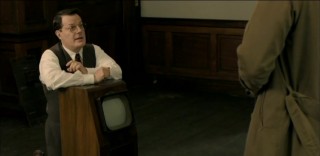by DAVID ROLINSON AND SIMON COWARD
Half-Hour Story Writer: Alun Owen; Producer: Stella Richman; Director: Alan Clarke
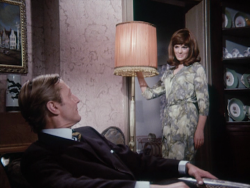 How and why is George’s Room in colour? Anyone coming to George’s Room knowing the rest of director Alan Clarke’s plays for Rediffusion’s Half-Hour Story strand thanks to the BFI’s Alan Clarke at the BBC set might wonder why this is the only one in colour and why it looks so different from the others.1 In comparison with the inventive compositions, fast cutting (vision mixing) and ambitious camerawork of plays like Stella, George’s Room seems highly conventional in its largely static compositions and its alternation between mid-shots, close-ups and wide two-shots: a reviewer at the time said that the play ‘has almost no movement’ and ‘could easily pass as a radio play’, watching characters ‘speaking or listening’.2 In the circumstances this is perhaps unsurprising. Clarke directed this colour version at Wembley Studios, using the same electronic multi-camera set-up as his black and white Half-Hour Story plays. However, George’s Room adapted this set-up in order to use ‘E-cam’, a system designed to make filmed drama in television studios. There were similar attempts to combine television and film technology elsewhere in the television and cinema industries – as we shall see – but Rediffusion were pioneering the integration of film and the electronic multi-camera studio. George’s Room was the main pilot experiment to test ‘E-cam’, which makes it a fascinating moment in British television drama, a stepping stone to possible futures in the use of colour and the convergence between television and cinema. This essay is the most detailed exploration of George’s Room to date. This might not be surprising, given that those studying Clarke could only access an incomplete version,3 until, as the BFI’s Sam Dunn explained, ‘the missing half […] was discovered hiding in the deep recesses of the National Archive’.4 This essay provides information on different stages – from commissioning to overseas sales – but its main focus is on the play as an experiment in colour and electronic film.
How and why is George’s Room in colour? Anyone coming to George’s Room knowing the rest of director Alan Clarke’s plays for Rediffusion’s Half-Hour Story strand thanks to the BFI’s Alan Clarke at the BBC set might wonder why this is the only one in colour and why it looks so different from the others.1 In comparison with the inventive compositions, fast cutting (vision mixing) and ambitious camerawork of plays like Stella, George’s Room seems highly conventional in its largely static compositions and its alternation between mid-shots, close-ups and wide two-shots: a reviewer at the time said that the play ‘has almost no movement’ and ‘could easily pass as a radio play’, watching characters ‘speaking or listening’.2 In the circumstances this is perhaps unsurprising. Clarke directed this colour version at Wembley Studios, using the same electronic multi-camera set-up as his black and white Half-Hour Story plays. However, George’s Room adapted this set-up in order to use ‘E-cam’, a system designed to make filmed drama in television studios. There were similar attempts to combine television and film technology elsewhere in the television and cinema industries – as we shall see – but Rediffusion were pioneering the integration of film and the electronic multi-camera studio. George’s Room was the main pilot experiment to test ‘E-cam’, which makes it a fascinating moment in British television drama, a stepping stone to possible futures in the use of colour and the convergence between television and cinema. This essay is the most detailed exploration of George’s Room to date. This might not be surprising, given that those studying Clarke could only access an incomplete version,3 until, as the BFI’s Sam Dunn explained, ‘the missing half […] was discovered hiding in the deep recesses of the National Archive’.4 This essay provides information on different stages – from commissioning to overseas sales – but its main focus is on the play as an experiment in colour and electronic film.
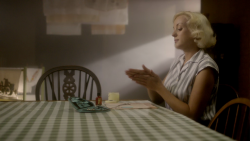 Call the Midwife often makes skilful use of editing to interweave its lead characters with its guest characters. This aids storytelling, heightens our understanding of characters in their social environment and at times even complicates the position of the midwives in that environment. This essay will explore editing and other aspects of form in two sequences from Call the Midwife series two episode five, to explore the ways in which the problems of guest character Nora Harding are interwoven with two lead characters: the first sequence is a well-executed piece of storytelling, whilst the second is an extraordinary use of technique to devastating effect.1
Call the Midwife often makes skilful use of editing to interweave its lead characters with its guest characters. This aids storytelling, heightens our understanding of characters in their social environment and at times even complicates the position of the midwives in that environment. This essay will explore editing and other aspects of form in two sequences from Call the Midwife series two episode five, to explore the ways in which the problems of guest character Nora Harding are interwoven with two lead characters: the first sequence is a well-executed piece of storytelling, whilst the second is an extraordinary use of technique to devastating effect.1
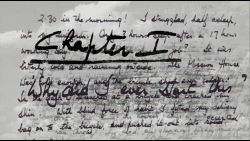
 How and why is George’s Room in colour? Anyone coming to George’s Room knowing the rest of director Alan Clarke’s plays for Rediffusion’s Half-Hour Story strand thanks to the BFI’s Alan Clarke at the BBC set might wonder why this is the only one in colour and why it looks so different from the others.
How and why is George’s Room in colour? Anyone coming to George’s Room knowing the rest of director Alan Clarke’s plays for Rediffusion’s Half-Hour Story strand thanks to the BFI’s Alan Clarke at the BBC set might wonder why this is the only one in colour and why it looks so different from the others.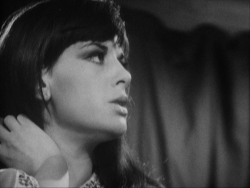 The BFI’s superb new Alan Clarke box sets contain many treats – they at last make most of the director’s surviving BBC work available to everyone and do so with such loving remastering and restoration that even those of us who have seen these pieces many times have never seen or heard them like this – but I’m particularly pleased with the bonus DVD on the main blu ray set
The BFI’s superb new Alan Clarke box sets contain many treats – they at last make most of the director’s surviving BBC work available to everyone and do so with such loving remastering and restoration that even those of us who have seen these pieces many times have never seen or heard them like this – but I’m particularly pleased with the bonus DVD on the main blu ray set 